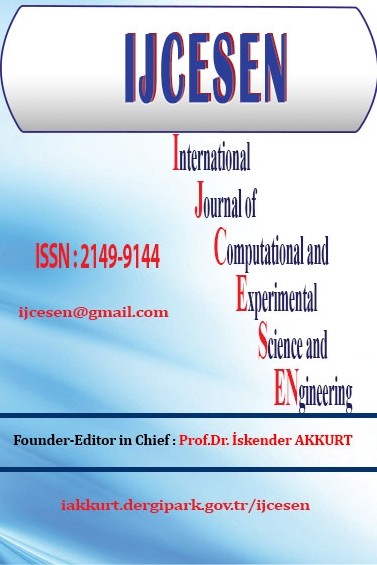Medical Data Analysis for Different Data Types
Medical Data Analysis for Different Data Types
Medical data informatics, Electronic health records, Data science, EDA Reproducible research,
___
- [1] Aggarwal, A. K. (2019). Opportunities and challenges of big data in public sector. In Web services: Concepts, methodologies, tools, and applications (pp. 1749-1761). IGI Global. doi: 10.4018/978-1-4666-9649-5.ch016
- [2] Oussous, A., Benjelloun, F. Z., Lahcen, A. A., & Belfkih, S. (2018). Big Data technologies: A survey. Journal of King Saud University-Computer and Information Sciences, 30(4), 431-448. doi: 10.1016/j.jksuci.2017.06.001
- [3] Shen, H. (2014). Interactive notebooks: Sharing the code. Nature, 515(7525), 151-152. doi: 10.1038/515151a
- [4] Kluyver, T., Ragan-Kelley, B., Pérez, F., Granger, B. E., Bussonnier, M., Frederic, J., ... & Ivanov, P. (2016, May). Jupyter Notebooks-a publishing format for reproducible computational workflows. In ELPUB (pp. 87-90). doi:10.3233/978-1-61499-649-1-87
- [5] McKinney, W. (2011). pandas: a foundational Python library for data analysis and statistics. Python for High Performance and Scientific Computing, 14(9).
- [6] Hunter, J. D. (2007). Matplotlib: A 2D graphics environment. Computing In Science Engineering 9, 3. 90-95. doi: 10.1109/MCSE.2007.55
- [7] Embarak, O. (2018). Data Visualization. In Data Analysis and Visualization Using Python (pp. 293-342). Apress, Berkeley, CA. 10.1007/978-1-4842-4109-7_7
- [8] Cuttone, A., Lehmann, S., & Larsen, J. E. (2016). geoplotlib: a Python Toolbox for Visualizing Geographical Data. arXiv preprint arXiv:1608.01933.
- [9] Pedregosa, F., Varoquaux, G., Gramfort, A., Michel, V., Thirion, B., Grisel, O., ... & Vanderplas, J. (2011). Scikit-learn: Machine learning in Python. the Journal of machine Learning research, 12, 2825-2830.
- [10] Leung, C. K. S. (2019). Big data analysis and mining. In Advanced Methodologies and Technologies in Network Architecture, Mobile Computing, and Data Analytics (pp. 15-27). IGI Global. doi: 10.4018/978-1-5225-2255-3.CH030
- [11] Loper, E., & Bird, S. (2002). NLTK: the natural language toolkit. arXiv preprint cs/0205028.
- [12] Saleiro, P., Kuester, B., Hinkson, L., London, J., Stevens, A., Anisfeld, A., ... & Ghani, R. (2018). Aequitas: A bias and fairness audit toolkit. arXiv preprint arXiv:1811.05577.
- [13] Detrano, R., Janosi, A., Steinbrunn, W., Pfisterer, M., Schmid, J. J., Sandhu, S., ... & Froelicher, V. (1989). International application of a new probability algorithm for the diagnosis of coronary artery disease. The American journal of cardiology, 64(5), 304-310. doi: 10.1016/0002-9149(89)90524-9
- [14] Strzelecki, M., Szczypinski, P., Materka, A., & Klepaczko, A. (2013). A software tool for automatic classification and segmentation of 2D/3D medical images. Nuclear Instruments and Methods in Physics Research Section A: Accelerators, Spectrometers, Detectors and Associated Equipment, 702, 137-140. doi: 10.1016/j.nima.2012.09.006
- [15] de Vos, B. D., Wolterink, J. M., de Jong, P. A., Viergever, M. A., & Išgum, I. (2016, March). 2D image classification for 3D anatomy localization: employing deep convolutional neural networks. In Medical imaging 2016: Image processing (Vol. 9784, p. 97841Y). International Society for Optics and Photonics. doi: 10.1117/12.2216971
- [16] Simonyan, K., & Zisserman, A. (2014). Very deep convolutional networks for large-scale image recognition. arXiv preprint arXiv:1409.1556.
- [17] Irvin, J., Rajpurkar, P., Ko, M., Yu, Y., Ciurea-Ilcus, S., Chute, C., ... & Seekins, J. (2019, July). Chexpert: A large chest radiograph dataset with uncertainty labels and expert comparison. In Proceedings of the AAAI Conference on Artificial Intelligence (Vol. 33, pp. 590-597). 10.1609/aaai.v33i01.3301590
- Yayın Aralığı: 4
- Başlangıç: 2015
- Yayıncı: Prof.Dr. İskender Akkurt
Nazmiye Deniz ARSLAN, H. Orhan KIZILKAYA, Ayşe KUTLUHAN
Calculated hyperfine coupling constants of some sigma-type radicals
Modeling Hyperelastic Materials by MATLAB
Ahmad ALDEEN, Yücel CAN, Murat YAZICI
Melise KARATAY KUTMAN, Fazilet Zümrüt BİBER MÜFTÜLER, Özge KOZGUŞ GÜLDÜ, Coşkun HARMANŞAH
Medical Data Analysis for Different Data Types
Aniekan IKPE, Akanu-ıbiam NDON, Promise ETİM
Virtual Reality Applications in Industrial Automation Systems: Industrial Robot Station Application
Akın ARAS, Murat AYAZ, Engin ÖZDEMİR, Nurettin ABUT
Characterization and siderophores production of Rhizobium spp. isolated from wild legumes
